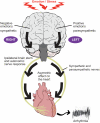Anger, emotion, and arrhythmias: from brain to heart
- PMID: 22022314
- PMCID: PMC3196868
- DOI: 10.3389/fphys.2011.00067
Anger, emotion, and arrhythmias: from brain to heart
Abstract
Strong emotion and mental stress are now recognized as playing a significant role in severe and fatal ventricular arrhythmias. The mechanisms, although incompletely understood, include central processing at the cortical and brain stem level, the autonomic nerves and the electrophysiology of the myocardium. Each of these is usually studied separately by investigators from different disciplines. However, many are regulatory processes which incorporate interactive feedforward and feedback mechanisms. In this review we consider the whole as an integrated interactive brain-heart system.
Keywords: anger; brain–heart system; emotion; mental stress.
Figures




References
-
- Armour J. A., Arndell J. L. (2004). Basic and clinical neurocardiology. Oxford, UK: Oxford University Press
-
- Bernardi L., Wdowczyk-Szulc J., Valenti C., Castoldi S., Passino C., Spadacine G., Sleight P. (2000). Effects of controlled breathing, mental activity, and mental stress with or without verbalisation on heart rate variability J. Am. Coll. Cardiol. 35, 1462–146910.1016/S0735-1097(00)00595-7 - DOI - PubMed
LinkOut - more resources
Full Text Sources

